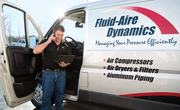>Inline air filters remove moisture, oil carryover, and dry particulates from compressed air. The right inline filtration can ensure a consistent supply of clean, dry air that fully meets your air quality requirements. Here’s everything you need to know about selecting, installing, and maintaining inline filters for your air compressor.
What Is an Inline Air Compressor Filter, and Why Do You Need One?
An inline filter for compressed air is a device that's integrated into a compressed air system to remove contaminants. Inline filters are installed directly into the system's air lines, as the name suggests, to efficiently filter out these impurities before the air reaches its point of use. These filters come in various types depending on what specific contaminants they're designed to remove, including dry particulate filters, coalescing oil filters, and adsorption (activated carbon) filters.
What do you need inline filtration? Compressed air contains contaminants when it leaves the compressor, including oils, particulates, and even microorganisms. The inline filter captures these contaminants before the compressed air meets your production environment. This ensures that the air that is used to power your machines and processes is as clean as required.
Problems Caused by Compressed Air Contamination
Contaminants in compressed air can build up within pneumatic equipment and in the compressed air system itself. Contamination in compressed air can cause significant problems for tools and equipment, product quality, worker health, and system efficiency. Appropriate inline filtration can help you avoid issues like these below.
- Equipment damage: Contaminants in the compressed air can cause abrasion, corrosion, or blockages in the system, leading to premature wear and tear or failure of equipment components. Dirty air can lead to early failure of valves, cylinders, and other moving parts in pneumatic equipment.
- Reduced efficiency: Contaminated compressed air can result in inefficient performance of pneumatic tools and machinery, increasing energy consumption and operational costs. Contaminant buildup in compressed air piping will reduce the overall efficiency of the system.
- Product contamination: In industries like food processing, pharmaceuticals, or electronics manufacturing, contaminated compressed air can lead to product contamination, affecting the quality and safety of the final product. Contamination in compressed air used in paint spray booths can cause bubbling and other quality issues with the coating.
- Increased maintenance costs: The presence of contaminants in compressed air can necessitate more frequent maintenance and cleaning of equipment, driving up maintenance costs.
- Downtime: Improper filtration can lead to equipment breakdowns and production delays, negatively impacting productivity and profitability.
- Health and safety risks: Compressed air contaminated with oil, water, or particulates can pose health and safety risks to workers, potentially leading to respiratory issues or other illnesses.
Types of Compressed Air Contamination
Compressed air can contain various contaminants that can affect the performance and reliability of the system, as well as the quality of the air for specific applications. These contaminants can originate from the ambient air, the compression process, or the compressor's components. To ensure the efficient and safe operation of compressed air systems, it is essential to understand the different types of contaminants and implement appropriate filtration solutions.
Dry Particulate

Dry particulate contaminants consist of solid particles such as dust, dirt, and rust that can enter the compressed air system from the ambient air or form during the compression process. These particles can cause abrasion, clogging, or blockages in the system, leading to reduced efficiency and equipment damage. Proper intake filters and inline particulate filters can help remove these solid contaminants to ensure clean and efficient compressed air.
Dry contaminants in compressed air are measured in micron size. A micron is one-millionth of a meter or 0.001 mm. The human eye can see particles as small as 50-60 microns, or a bit less than the diameter of a human hair. Contaminants in compressed air systems can be much smaller than this. About 80% of industrial contaminants are in the fine (less than 2.5 microns) or ultra-fine (less than 0.1 microns) range.
Oil Carryover
Oil carryover is the presence of oil aerosols or vapors in compressed air, which is typically caused by the lubrication process in oil-lubricated compressors. These oil contaminants can lead to product contamination in sensitive applications and affect the performance of pneumatic tools. To address oil carryover, coalescing filters, and activated carbon filters can be used to remove oil aerosols and vapors from the compressed air.
Moisture
Moisture is a common contaminant in compressed air systems, as the compression process causes the water vapor in the ambient air to condense into liquid water. If not properly removed, moisture can cause corrosion, bacterial growth, and freezing in low-temperature applications, leading to equipment damage and reduced efficiency. In addition to compressed air filtration, aftercoolers and air dryers can be used to remove excess liquid from the air supply. In-line filtration is typically the last line of defense against moisture once other air treatment methods have been applied.
Microorganisms

Microorganisms such as bacteria, mold, and fungi can enter the compressed air system from the ambient air or grow in the presence of moisture. These biological contaminants can pose health risks to workers and lead to product contamination in industries like food processing and pharmaceuticals. To mitigate the risks associated with microorganisms, sterile filters and proper system maintenance, including regular cleaning and inspection, can help maintain the air quality and prevent microbial growth.
Types of Inline Air Compressor Filters
The combination of air compressor filters you need will depend on the type of air compressor you have, the purity of air you require, and what you are trying to filter out.
- Dry particulate filters, as their name implies, remove only dry dust and particulate.
- Coalescing filters remove both particulate and aerosolized liquids.
- Adsorption filters remove gases, vapors, and odors.
Dry Particulate Filters
Dry particulate filters remove dry particulate from the airstream. Dirt particles are trapped by the filter media through direct interception, inertial impact, or diffusion. Large particles are directly blocked by the fibers in the filter media. Smaller particles are intercepted as they move erratically through the media via Brownian motion (diffusion). These particles are held in the media through electrostatic attraction.
Coalescing Inline Filter

A coalescing filter is another type of inline air compressor filter. An oil coalescing air filter is a type of air line filter that removes both oil mists or oil vapors and dry particulates. A coalescing filter works by trapping mists and aerosols in layers of fine mesh. Aerosolized oil particles and water droplets collect on the surface of filter media and coalesce into larger and larger droplets until they are heavy enough to fall. The liquid is collected at the bottom of the filter and drained away. Fine particulates fall out with the liquid, while coarser particles remain trapped in the filter media.
Coalescing filters provide superior filtration for both particulates and aerosols. They can remove aerosolized droplets and particles down to 0.01 microns and remaining oil to .008 PPM or lower. They may be used alone or in combination with other filters.
Adsorption Filters
An adsorption air compressor filter is used to trap vapors, gaseous contaminants, chemical fumes, and odors. These filters are used for high-purity applications that require the removal of trace gases and vapors along with sub-micron particulates. Activated carbon is the most common material used for adsorption.
In adsorption technologies, molecules of a gas, liquid, or dissolved solid adhere to the surface of a material inside the filter cartridge. Adsorptive materials like activated carbon have millions of tiny micropores, which increase the available surface area for adhesion. Molecules bond to these surfaces and are trapped within the micropores.
An activated carbon inline filter can remove unwanted vapors, gases, and noxious odors from compressed air. It should be used in combination with a compressed air dryer (either a refrigerated dryer or adsorption dryer) and a coalescing filter to remove oil mists and dry particulate from the air before it hits the adsorption filter.
2-in-1 Filters
A 2-in-1 inline filter for compressed air is a multi-stage filter that combines two different filtration elements into a single unit. These filters are designed to remove more than one type of contaminant from the air, saving space and potentially reducing costs compared to installing separate filters for each type of contaminant. For example, a 2-in-1 filter may combine a prefilter with an activated carbon adsorption filter to remove both dry particulate and gaseous or vapor emissions.
Choosing the Best Inline Filter for Your Needs
There are several factors to consider when choosing filtration for your compressed air system. High-quality filters will reduce maintenance requirements, minimize pressure drop, improve energy efficiency, and ensure a consistent supply of clean, dry air.
Filter Quality
Installing a high-quality air filter may cost a bit more up front, but it will pay off in the end. High-quality inline compressed air filters will last longer and require less maintenance. They also are less likely to have failures that allow contaminants to escape past the filter, ensuring that air quality will meet the requirements of your application. Always purchase compressed air filters from a trusted and reliable manufacturer to safeguard your equipment and processes.
Filtration Efficiency
There are two elements to filtration efficiency for an oil-lubricated air compressor: particulate filtration efficiency (measured in microns) and oil carryover (measured in parts per million, or PPM).
- Filtration efficiency for dry particulate is measured by the size of the particle the filter can capture (micron rating) the the percentage of particulate captured. A standard dry particulate inline filter is generally rated to remove particles down to 3 microns in size with 99.99% efficiency. Coalescing filters remove fine particles along with oil. A utility-grade coalescing filter will remove particles down to 1 micron with 99.999% efficiency, while a high-efficiency coalescing filter will remove particles down to 0.01 microns with 99.999% efficiency.
- Oil removal of a given filter is rated in remaining oil going downstream measured in PPM, or parts per million. A utility-grade coalescing filter typically has oil carryover of about 0.4 PPM, while high-efficiency coalescing filters can get down to 0.008 PPM. Activated carbon adsorption filters may get oil carryover as low as 0.002 PPM.
Pressure Drop
When selecting filters for your compressor system, there's often a trade-off between pressure drop and filtration efficiency. Pressure drop is defined as the difference in air pressure (PSI) measured before and after the filter; a higher pressure drop indicates that the system is working harder to push air through the filter. High filtration efficiency typically requires a denser filter media or smaller pore size, which can increase pressure drop across the filter and thus the energy requirements for the system. Striking the right balance between pressure drop and filtration efficiency is essential to maintain clean compressed air while minimizing energy consumption and operational costs. Select a filter that provides the necessary filtration efficiency while minimizing pressure drop to ensure optimal system performance and energy efficiency.
Filter Media
The filter media is the material used in the filter element to capture and remove contaminants. Common filter media materials include paper, polyester, cellulose, glass fibers, stainless steel, or synthetic materials. Each material has unique properties that affect filtration efficiency, pressure drop, and service life. Choose a filter media that provides the desired filtration performance while considering factors like operating environment, temperature, and humidity.
Flow Rate
The flow rate refers to the volume of air that can pass through the filter per unit of time, typically measured in cubic feet per minute (CFM) or liters per second (L/s). Choose a filter with a flow rate capacity that matches or exceeds your air compressor's output to ensure proper filtration without causing restrictions or reducing efficiency.
Service Life
Service life is the expected operating time before the filter needs to be replaced or serviced. Longer service life can reduce maintenance costs and downtime. When selecting a filter, consider factors like the operating environment and contaminant levels, and choose a filter with a service life that meets your maintenance schedule and budget.
How Clean Does Compressed Air Need to Be?
The quality of compressed air is important. Clean, dry compressed air is a benefit for any operation, but the tolerance for contaminants in compressed air varies widely by application. Under ISO 8573, compressed air purity is classified according to three parameters: dry particulate (measured by number and size), moisture (by Vapor Pressure Dew Point or liquid mass), and oil carryover (measured in mass).
- If you are using air for pneumatic purposes (to power tools, machinery and conveyors), then a standard particulate filter may provide sufficient filtration. Choose a basic utility coalescing inline filter to also remove oil mists.
- Paint lines and similar applications require a higher degree of purity, with particulate removal down to 0.1 micron and very low levels of oil carryover. High-efficiency coalescing inline filters can provide this level of purity.
- Processes such as food processing, pharmaceuticals and nutraceuticals, and medical applications require compressed air of very high purity. Adding activated carbon filtration will remove gasses and vapors from the air.
How to Install an Inline Air Filter for an Air Compressor
Inline compressed air filters can be placed anywhere in the compressed air piping systems. Some of the most common placements are the following:
- Directly after the commercial air compressor.
- Before and after the air dryer (refrigerated air dryers, desiccant air dryers).
- Just prior to point-of-use (i.e., on each compressed air drop).
Depending on your application and air purity requirements, you may install multiple inline filters sequentially or at different places in your system. Inline filtration can be easily configured to your specific needs.
Filtering compressed air before it enters the main distribution piping is usually the most efficient solution. Point-of-use inline filtration can be costly to install and maintain. Efficient inline filtration of air before it enters the compressed air distribution system can usually eliminate the need for point-of-use filtration.
How Often Should You Change the Inline Filter for Your Air Compressor?
As a general industry rule, it is recommended that you change your inline air compressor filter at least once a year or after 8,000 hours of operation. Like all filters, inline air compressor filters require regular maintenance to ensure that they maintain their filtration efficiency. If you do not change your filters frequently enough, you will notice an increased pressure drop as the filter becomes more loaded. This will reduce the efficiency of your compressed air system and drive up energy costs. An overloaded filter will also impact the quality of your compressed air.
Aire Tip: Keep an eye on the differential pressure gauge to know when it is time to change your inline filter.
There are a few variables that will impact filter life and necessitate more frequent filter changes. These include:
- High oil carryover from the compressor equipment, caused the inline filter to become saturated faster than usual.
- Increased amounts of particulate due to corrosion within the piping and/or equipment
- Improperly sized filtration.
Aire Tip: Change your float drain at the same time you change your inline filter(s).
The Best Inline Filter for Air Compressors
The best inline air compressor filter for you depends on your application, usage patterns, and air purity requirements. We can help you select the best inline filter for your compressed air needs.
There are four different types of inline filtration offered by PneuTech: particulate, coalescing, activated carbon, and 2-in-1 filtration.
- Utility Coalescing: Utility-grade coalescing elements offer a particulate removal down to 1 micron and a maximum oil carryover of 0.4 PPM. These elements are typically used as pre-filtration to your compressed air dryer.
- High-Efficiency Coalescing: High-efficiency coalescing elements offer a particulate removal down to 0.01 microns and a maximum oil carryover of 0.008 PPM. These elements are typically used as post-filtration to your compressed air dryer.
- Activated Carbon: This type of filter removes hydrocarbon mist and vapor. It is used in many different applications, but mostly in industries such as food processing and pharmaceutical. Activated carbon elements offer a max carryover of 0.002 PPM.
- 2-in-1 Filter: The 2-in-1 filter element is unique in its design, offering particulate removal down to 1 micron as well as oil adsorption through its bed of activated carbon material. This element is ideal for pre-filtration on a desiccant dryer.
Not sure which filter is right for you? Give us a call at 866-432-6379. We can help you design an inline filtration solution to deliver compressed air of the purity you need.
©2024 Fluid-Aire Dynamics, Inc. All Rights Reserved.






